Ideal LAN
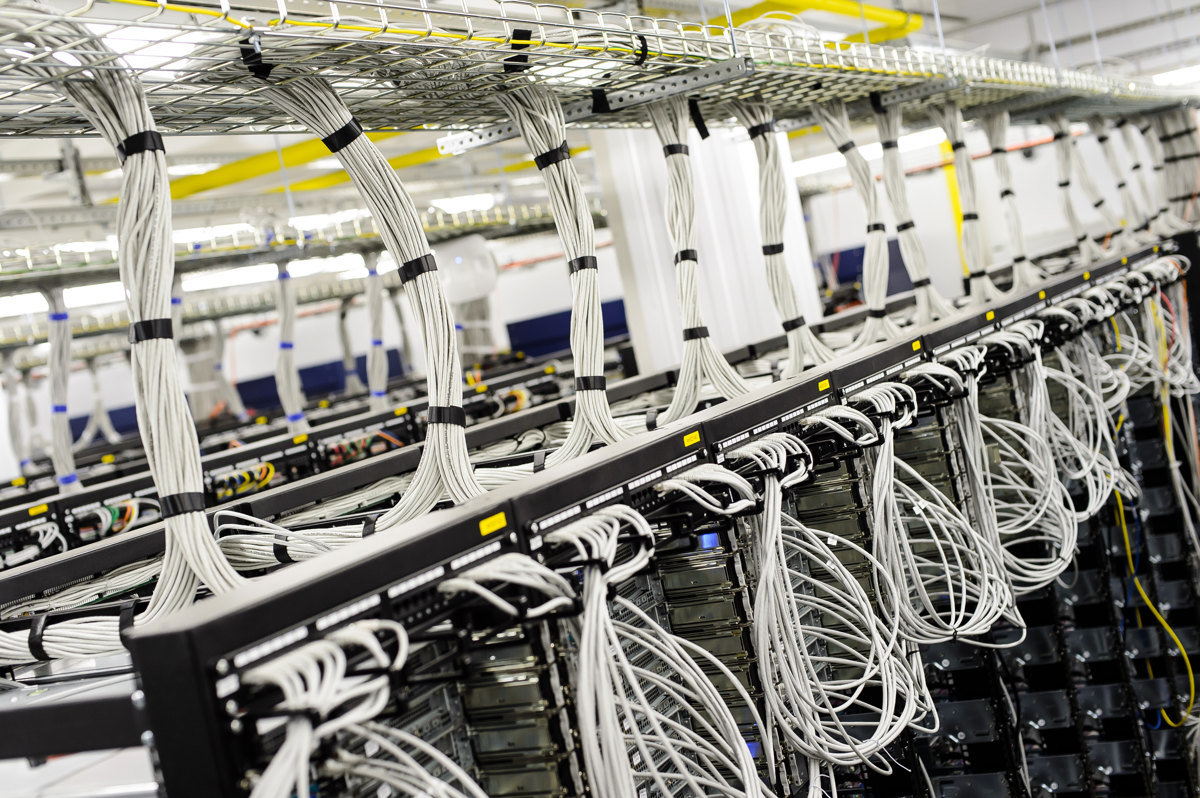
The standard local area network in its current (averaged) form was finally formed many years ago, whereupon its development stopped.
On the one hand, the best is the enemy of the good, on the other, stagnation is not too good either. Moreover, upon closer inspection, a modern office network that allows you to perform almost all the tasks of a regular office can be built cheaper and faster than is commonly believed, and its architecture will become simpler and more scalable. Do not believe? And let's try to figure it out. And to begin with, what is considered the proper network routing.
What is SCS?
Any structured cabling system (SCS) as the final element of the engineering infrastructure is implemented in several stages:
- design;
- Actually, installation of cable infrastructure;
- installation of access points;
- installation of switching points;
- commissioning works.
Design
Any big deal, if you want to do it well, begins with preparation. For SCS, such preparation is design. It is at this stage that it takes into account how many jobs need to be provided, how many ports need to be placed, what potential for bandwidth to lay. At this stage it is necessary to be guided by standards (ISO / IEC 11801, EN 50173, ANSI / TIA / EIA-568-A). In fact, it is at this stage that the boundary capabilities of the network being created are determined.
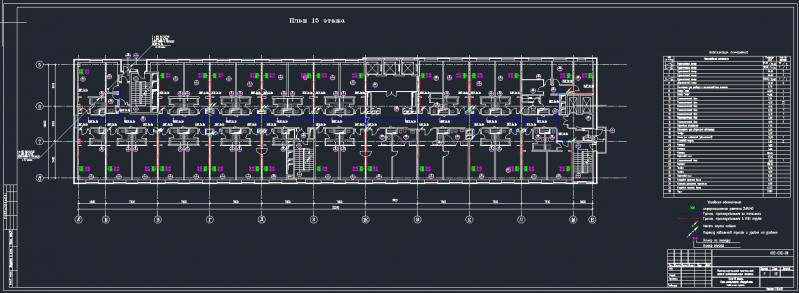
Cable infrastructure

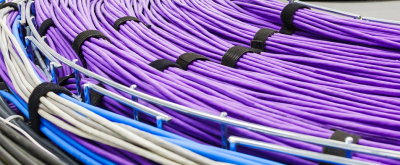
At this stage, all cable lines are laid, providing data transfer over a local network. Kilometers of copper cable symmetrical twisting. Hundreds of kilograms of copper. The need to install cable ducts and trays - without them, the construction of a structured cable system is impossible.
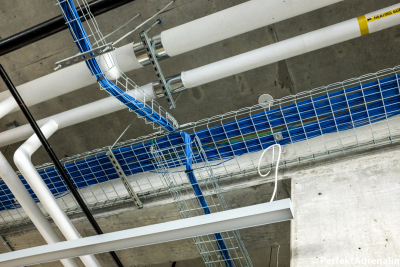
Access points
To provide jobs with access to the network, access points are laid. Guided by the principle of redundancy (one of the most important in the construction of SCS), such points are laid in an amount exceeding the minimum required amount. By analogy with the electric network: the more outlets - the more flexible you can use the space in the territory of which such a network is located.
Switching Points, Poland
Then the main and, as an option, intermediate switching points are mounted. Racks / telecom cabinets are placed, cables and ports are marked, connection is made inside the consolidation points and in the cross node. A switching journal is compiled, which is subsequently updated throughout the life of the cable system.
When all installation steps are completed, the entire system is tested. Cables are connected to active network equipment, the network rises. The correspondence of the declared frequency bandwidth (transmission speed) declared for a given SCS is checked, the designed access points are called up and all the other parameters important for the operation of the SCS are checked. All identified deficiencies are eliminated. Only after that, the network is transferred to the customer.
The physical environment for transmitting information is ready. What's next?
What "lives" in the SCS?
Previously, data from a wide variety of systems, closed to their technologies and protocols, were transmitted over the cable infrastructure of the local network. But the technology zoo has long been multiplied by zero. And now, only Ethernet has remained in the LAN. Telephony, video from surveillance cameras, fire alarms, security systems, utility meter data, access control systems and a smart intercom, in the end - all this now goes over Ethernet.

Smart intercom, access control system and remote control device SNR-ERD-PROject-2
We optimize the infrastructure
And the question arises: with the continuous development of technology, do we still need all parts of the traditional SCS?
Hardware and software switching
It's time to recognize the obvious, in general, thing: hardware switching at the level of crosses and patch cords has become obsolete. Everything has been done for a long time by VLAN ports, and administrators sorting wires in cabinets at any change in the network structure is atavism. It's time to take the next step and just abandon crossovers and patch cords.
And it seems to be a trifle, but if you think about it, there will be more benefit from this step than from switching to the next category cable. Judge for yourself:
- The quality of the physical medium of signal transmission will increase.
- Reliability will increase, because we remove two mechanical contacts from three (!) From the system.
- As a result, the signal transmission range will increase. Not fundamentally, but still.
- The cabinets will suddenly free up space. And the order there, by the way, will be much more. And this is a cost savings.
- The cost of the cleaned equipment is small, but if you take into account the whole scale of optimization, a good amount of savings can also be accumulated.
- If there is no cross-connect switching, you can crimp client lines directly under RJ-45.
What is it? We simplified the network, made it cheaper, and moreover, it became less buggy and more manageable. Solid pluses!
Or maybe, then, throw something else? :)
Fiber instead of copper core
And why do we need kilometers of twisted pair, when the entire amount of information that goes through a thick bundle of copper wires can easily be transmitted through optical fiber? Let's put in the cabinet an 8-port switch with an optical uplink and, for example, PoE support. From the cabinet to the cabinet - one fiber optic core. From switch to clients, copper wiring. In this case, IP-phones or surveillance cameras can be provided immediately and power.

At the same time, not only the mass of copper cable in the beautiful trellised trays is cleaned, but also the means that are needed to lay all this, traditional for SCS, splendor are saved.
True, such a scheme is somewhat contrary to the idea of the “correct” placement of equipment in one place, and the savings on cable and multiport switches with copper ports will be spent on the purchase of small switches with PoE and optics.
On the client side
Cable on the client side appeared back in those days when wireless technology looked more like a toy than a real working tool. Modern "cordless" easily gives speed no less than the cable provides now, but it allows you to untie the computer from a fixed connection. Yes, the airtime is not rubber, and you won’t be able to infuse it with channels, but, firstly, the distance from the client to the access point can be very small (office needs allow this), and secondly, there are already new types of technologies that use for example, optical radiation (for example, the so-called Li-Fi).
With requirements for a range of 5-10 meters, so that 2-5 users are enough to connect, the access point can fully support a gigabit channel, at the same time cost very little and be absolutely reliable. This will save the end user from wires.
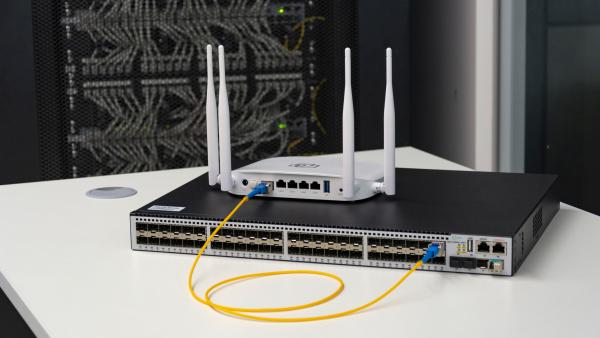
Optical switch S NR-S2995G-48FX and a gigabit wireless router connected by an optical patch cord
In the near future, this feature will be provided by devices operating in the millimeter range (802.11ad / ay), but for now, albeit with lower, but still excessive for office employees speeds, this can be done on the basis of the 802.11ac standard.
True, in this case, the approach to connecting devices such as IP phones or video cameras is changing. First, they will have to provide separate power through the PSU. Secondly, these devices must support Wi-Fi. However, no one forbids for the first time leaving at the access point a certain number of copper ports. At least for backward compatibility or unforeseen needs.
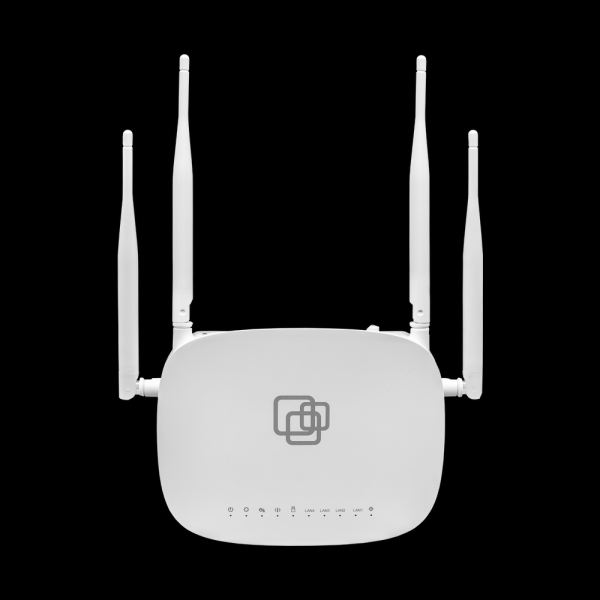
As an example, the wireless router SNR-CPE-ME2-SFP , 802.11a / b / g / n, 802.11ac Wave 2, 4xGE RJ45, 1xSFP
The next step is logical, right?
We will not stop there. Connect the access points with a fiber optic cable with a bandwidth of, say, 10 gigabits. And forget about the traditional SCS, as about a bad dream.
The circuit becomes simple and elegant.

Instead of heaps of cabinets, and trays clogged with copper cable, we put a small cabinet in which the switch “lives” with optical “tens” for every 4-8 users, and we pull the fiber to the access points. If necessary, for the old equipment you can also place some additional “copper” ports here - they will not interfere with the main infrastructure.
All Articles